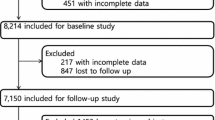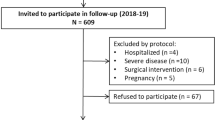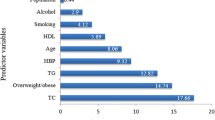Summary
Risk factors measured in a cross-sectional study in subjects aged 65–74 years living in eastern Finland were correlated with the risk of developing diabetes 3.5 years later. Sixty-nine of 892 initially non-diabetic subjects developed diabetes during the follow-up. Subjects who subsequently developed diabetes had multiple adverse changes in risk factor levels before the diagnosis of diabetes. Subjects who developed diabetes had higher body mass index and waist-hip ratio as well as higher levels of fasting and 2-h plasma glucose and insulin and higher prevalence of family history of diabetes than those who remained healthy. Furthermore, prevalence of hypertension and levels of diastolic blood pressure and total triglycerides were higher and HDL cholesterol lower among subjects who developed diabetes than among those who remained healthy. The highest risk of developing diabetes was associated with impaired glucose tolerance (World Health Organisation criteria) (odds ratio = 9.8,95% confidence interval = 6.1–5.8). The risk of developing diabetes was 3.7 (3.2–6.1) among subjects in the highest quartile of 2-h insulin distribution, 3.5 (2.0–6.1) in those with triglycerides greater than 2.5 mmol/l,2.7 (1.5–4.6) in those with waist-hip ratio greater than 1.0,2.5 (1.5–4.4) in those with HDL cholesterol less than 1.0 mmol/l, 2.1 (1.2–3.6) in those with body mass index greater than 30 kg/m2, 1.9 (1.1–3.3) among those in the highest quartile of fasting insulin distribution, 1.8 (1.0–3.1) in those having hypertension, and 1.7 (1.0–2.9) in those with a family history of diabetes. The risk of diabetes increased by clustering of risk factors related to insulin resistance (impaired glucose tolerance, triglycerides >2.5 mmol/l, HDL cholesterol <1.0, hypertension) so that the risk was 3.6-fold in those having one risk factor and 59-fold in those having all four risk factors compared to subjects having no risk factors. In conclusion, cardiovascular risk factors related to insulin resistance are predictors of diabetes in the elderly.
Article PDF
Similar content being viewed by others
Avoid common mistakes on your manuscript.
References
Keen H, Jarrett RJ, McCartney P (1982) The ten-year follow-up of the Bedford survey (1962–1972): glucose tolerance and diabetes, Diabetologia 22: 73–78
Haffner SM, Stern MP, Mitchell BD, Hazuda HP, Patterson JK (1990) Incidence of type 2 diabetes in Mexican Americans predicted by fasting insulin and glucose levels, obesity, and body-fat distribution. Diabetes 39:283–288
Charles MA, Fontbonne A, Thibult N, Warnet J-M, Rosselin GE, Eschwege E (1991) Risk factors for NIDDM in white population. Paris Prospective Study. Diabetes 40:796–799
Jarrett RJ, Keen H, Fuller JH, McCartney M (1979) Worsening of diabetes in men with impaired glucose tolerance (“borderline diabetes”). Diabetologia 16:25–30
King H, Zimmet P, Raper LR, Balkau B (1984) The natural history of impaired glucose tolerance in the Micronesian population of Nauru: a six-year follow-up study. Diabetologia 26:39–43
Saad MF, Knowler WC, Pettitt DJ, Nelson RG, Mott DM, Bennett PH (1988) The natural history of impaired glucose tolerance in the Pima Indians. N Engl J Med 319:1500–1506
Sicree RA, Zimmet PZ, King HOM, Coventry JS (1987) Plasma insulin response among Nauruans. Prediction of deterioration in glucose tolerance over 6 yr. Diabetes 36:179–186
Lillioja S, Mott DM, Howard BV et al. (1988) Impaired glucose tolerance as a disorder of insulin action. Longitudinal and cross-sectional studies in Pima Indians. N Engl J Med 318:1217–1225.
Warram JH, Martin BC, Krolewski AS, Soeldner JS, Kahn R (1990) Slow glucose removal rate and hyperinsulinemia precede the development of type 2 diabetes in the offspring of diabetic parents. Ann Int Med 113:909–915
Ohlson L-O, Larsson B, Björntorp P et al. (1988) Risk factors for type 2 (non-insulin-dependent) diabetes mellitus. Thirteen and one-half years of follow-up of the participants in a study of Swedish men born in 1913. Diabetologia 31:798–805
Haffner SM, Stern MP, Hazuda HP, Mitchell BD, Patterson JK (1990) Cardiovascular risk factors in confirmed prediabetic individuals. Does the clock for coronary heart disease start ticking before the onset of clinical diabetes? JAMA 263:2893–2898
McPhillips JB, Barrett-Connor E, Wingard DL (1990) Cardiovascular disease risk factors prior to the diagnosis of impaired glucose tolerance and non-insulin-dependent diabetes mellitus in a community of older adults. Am J Epidemiol 131: 443–453
Papoz L, Eschwege E, Warnet J-M, Richard J-L, Claude J-R (1982) Incidence and risk factors of diabetes in the Paris Prospective Study (G.R.E.A.) In: Eschwege E (ed) Advances in diabetes epidemiology. Elsevier Biomedical Press, Amsterdam, pp 113–122
Harris MI, Hadden WC, Knowler WC, Bennett PH (1987) Prevalence of diabetes and impaired glucose tolerance and plasma glucose levels in U.S. population aged 20–74 yr. Diabetes 36: 523–534
Mykkänen L, Laakso M, Uusitupa M, Pyörälä K (1990) Prevalence of diabetes and impaired glucose tolerance in elderly subjects and their association with obesity and family history of diabetes. Diabetes Care 13:1099–1105
Mykkänen L, Laakso M, Penttilä I, Pyörälä K (1991) Asymptomatic hyperglycemia and cardiovascular risk factors in the elderly. Atherosclerosis 88:153–161
World Health Organization (1985) Diabetes mellitus. Report of a WHO Study Group. (Tech. Rep. Ser. No. 727). World Health Organization, Geneva
Hales CN, Randle PJ (1963) Immunoassay of insulin with insulin antibody precipitate. Biochem J 88:137–146
Penttilä IM, Voutilainen E, Laitinen P, Juutilainen P (1981) Comparison of different analytic and precipitation methods for direct estimation of serum high-density lipoprotein cholesterol. Scand J Clin Lab Invest 41:353–360
Siedel J, Hägele EO, Ziegenhorn J, Wahlefeld AW (1983) Reagent for the enzymatic determination of serum total cholesterol with improved lipolytic efficiency. Clin Chem 29:1075–1080
Wahlefeld AW (1974) Triglyceride determination after enzymatic hydrolysis. In: Bergmeyer HV (ed) Methods of enzymatic analysis. 2nd ed. Verlag Chemie Weinheim and Academic Press, New York, pp 1831–1835
Norusis MJ (1986) SPSS/PC+TM for the IBM PC/XT/AT, SPSS, Chicago
Agner E, Thorsteinsson B, Eriksen M (1982) Impaired glucose tolerance and diabetes mellitus in elderly subjects. Diabetes Care 5:600–604
Stern MP, Rosenthal M, Haffner SM (1985) A new concept of impaired glucose tolerance. Relation to cardiovascular risk. Arteriosclerosis 5:311–314
Medalie JH, Papier CM, Goldbourt U, Herman JB (1975) Major factors in the development of diabetes mellitus in 10,000 men. Arch Intern Med 135:811–817
Haffner SM, Valdez RA, Hazuda HP, Mitchell BD, Morales PA, Stern MP (1992) Prospective analysis of the insulin-resistance syndrome (Syndrome X). Diabetes 41:715–722
Ohlson L-O, Larsson B, Svärdsudd K et al. (1985) The influence of body fat distribution on the incidence of diabetes mellitus. 13.5 years of follow-up of participants in the study of men born in 1913. Diabetes 34:1055–1058
Lundgren H, Bengtsson C, Blohme G, Lapidus L, Sjöström L (1989) Adiposity and adipose tissue distribution in relation to incidence of diabetes in women: results from a prospective population study in Gothenburg, Sweden. Int J Obes 13:413–423
Larsson B, Svärdsudd K, Welin L, Wilhelmsen L, Björntorp P, Tibblin G (1984) Abdominal adipose tissue distribution, obesity, and risk of cardiovascular disease and death: 13 year follow-up of participants in the study of men born in 1913. Br Med J 288: 1401–1404
Lapidus L, Bengtsson C, Larsson B, Pennert K, Rybo E, Sjöström L (1984) Distribution of adipose tissue and risk of cardiovascular disease and death: a 12 year follow-up of participants in the population study of women in Gothenburg, Sweden. Br Med J 289:1257–1261
Ferrannini E, Barrett EJ, Bevilacqua S, DeFronzo RA (1983) Effect of fatty acids on glucose production and utilization in man. J Clin Invest 72:1737–1747
Lillioja S, Bogardus C, Mott DM, Kennedy AL, Knowler WC, Howard BV (1985) Relationship between insulin-mediated glucose disposal and lipid metabolism in man. J Clin Invest 75: 1106–1115
Boström K, Boren J, Wettesten M et al. (1988) Studies on the assembly of apo-B-100-containing lipoproteins in Hep G2 cells. J Biol Chem 263:4434–4442
Björntorp P (1990) Portal' adipose tissue as a generator of risk factors for cardiovascular disease and diabetes. Arteriosclerosis 10:493–495
Haffner SM, Ferrannini E, Hazuda HP, Stern MP (1992) Clustering of cardiovascular risk factors in confirmed prehypertensive individuals. Hypertension 20:38–45
Ferrannini E, Buzzicoli G, Bonadonna R, et al. (1987) Insulin resistance in essential hypertension. New Engl J Med 317:350–357
Laakso M, Sarlund H, Mykkänen L (1989) Essential hypertension and insulin resistance in non-insulin-dependent diabetes. Eur J Clin Invest 19:518–526
Hollenbeck CB, Chen N, Chen Y-DI, Reaven GM (1984) Relationship between the plasma insulin response to oral glucose and insulin-stimulated glucose utilization in normal subjects. Diabetes 33:460–463
Riccardi G, Vaccaro O, Rivellese A, Pignalosa S, Tutino L, Mancini M (1985) Reproducibility of the new diagnostic criteria for impaired glucose tolerance. Am J Epidemiol 121:422–429
Yudkin JS, Alberti KGMM, McLarty DG, Swai ABM (1990) Impaired glucose tolerance. Is it a risk factor for diabetes or a diagnostic ragbag? Br Med J 301:397–402
Feskens EJM, Bowles CH, Kromhout D (1991) Intra-and inter-individual variability of glucose tolerance in an elderly population. J Clin Epidemiol 44:947–953
Author information
Authors and Affiliations
Rights and permissions
About this article
Cite this article
Mykkänen, L., Kuusisto, J., Pyörälä, K. et al. Cardiovascular disease risk factors as predictors of Type 2 (non-insulin-dependent) diabetes mellitus in elderly subjects. Diabetologia 36, 553–559 (1993). https://doi.org/10.1007/BF02743273
Received:
Revised:
Issue Date:
DOI: https://doi.org/10.1007/BF02743273




